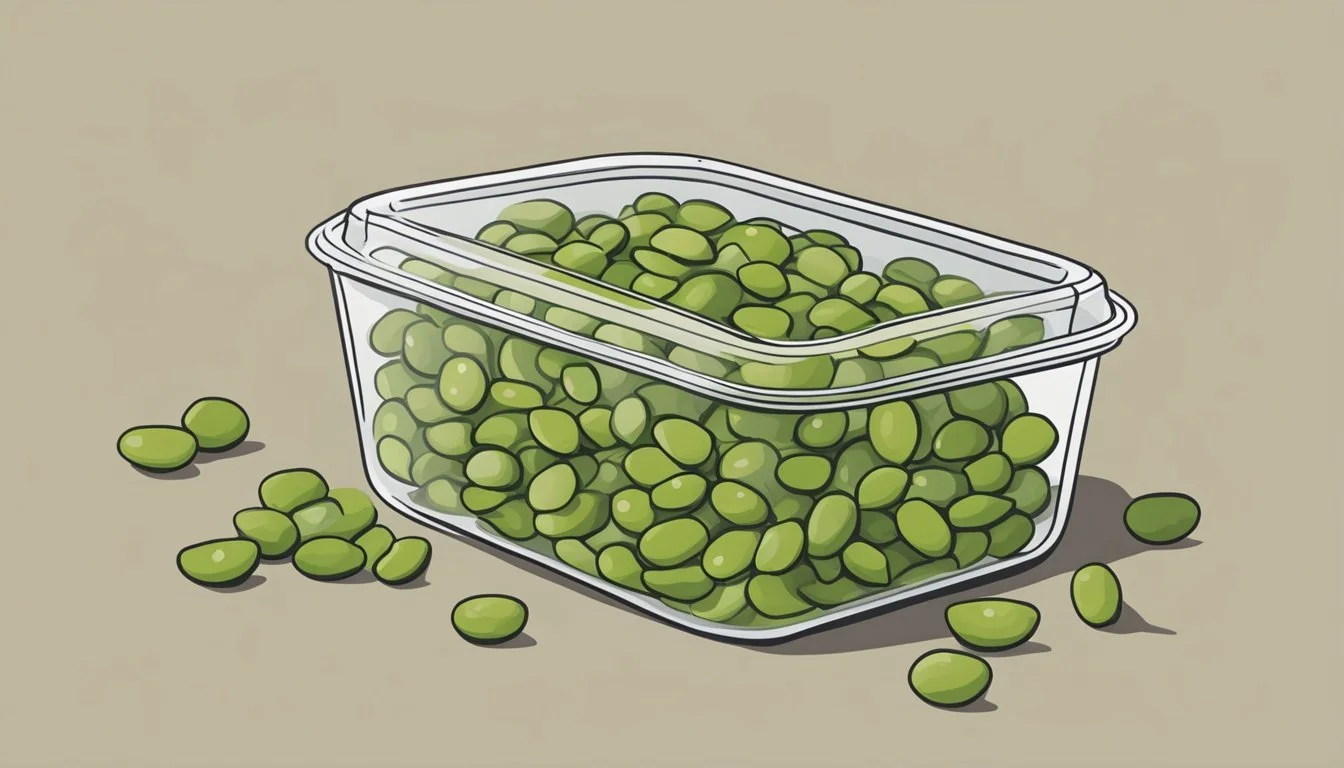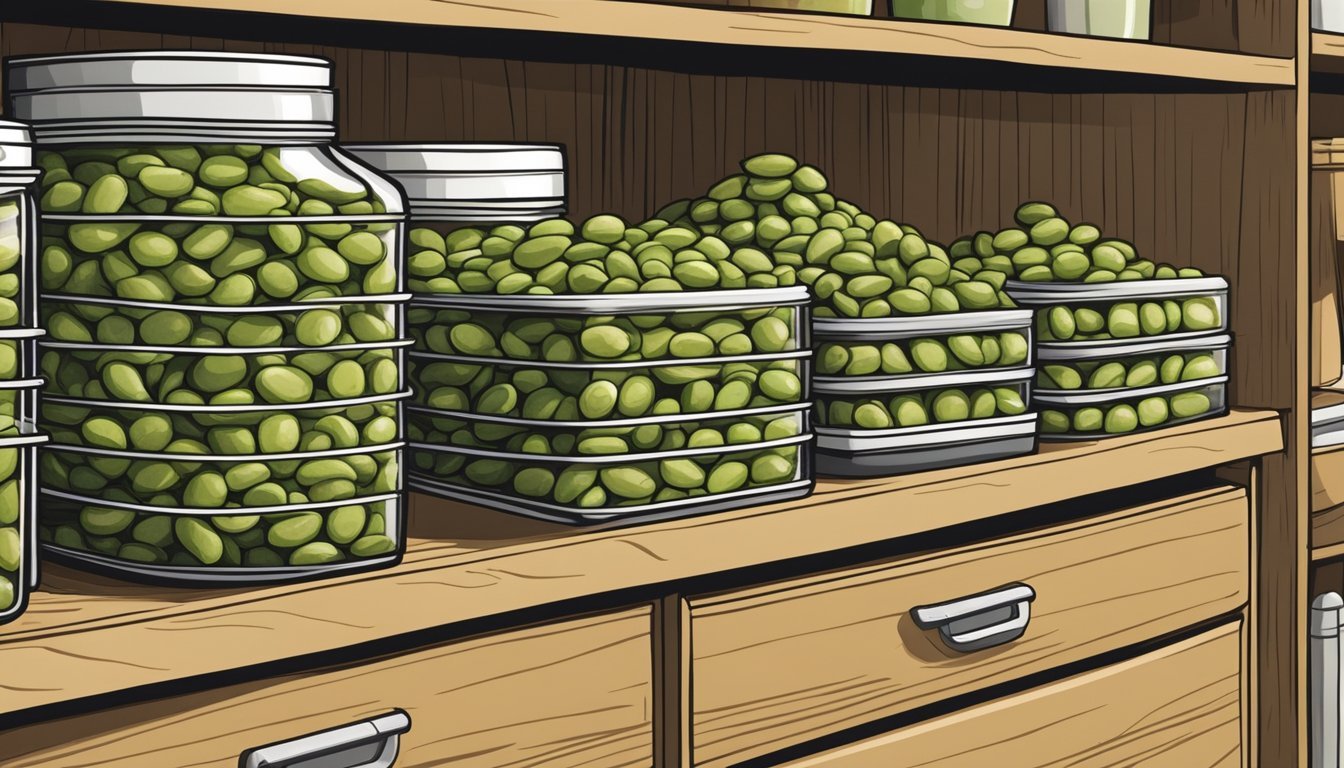How Long Do Roasted Edamame Last?
Shelf Life and Storage Tips
Edamame, young soybeans commonly served as a snack, are appreciated for their taste and nutritional benefits. Whether boiled or steamed, these beans offer a versatile eating experience. When roasted, edamame takes on a satisfying crunch, making them an even more appealing snack option. Roasting not only enhances flavor but can also influence the shelf life of this healthy treat.
Roasted edamame, when stored properly, can last for a variable period of time. Their shelf life is contingent upon factors like the storage temperature, method, and whether they are kept in an airtight container. In a pantry setting, roasted edamame can serve as a convenient, ready-to-eat snack over a short term. Refrigeration, while not always necessary, can extend the freshness and quality of the snack for a longer duration.
Roasted Edamame Overview
Roasted edamame is a simple and tasty snack that offers a wealth of nutritional benefits. Made from whole, fresh edamame beans, roasting them enhances their natural crunchiness while preserving most of their nutritional value.
Nutritional Profile
Roasted edamame beans are a rich source of protein, making them a popular choice among vegetarians and vegans. A one-cup serving typically contains:
Protein: Around 17 grams, which is essential for muscle repair and growth.
Fiber: Approximately 8 grams, aiding in digestion and promoting a feeling of fullness.
Iron: Crucial for transporting oxygen in the blood.
Calcium: Important for bone health.
Vitamins: A range of B vitamins including folate, which is vital for DNA synthesis and repair, as well as vitamin K.
They are also a source of other minerals, providing a nutritious option for a healthy diet.
Health Benefits
The nutrients found in roasted edamame contribute to its health benefits. They include:
Supporting heart health due to their high fiber content.
Aiding in maintaining healthy blood sugar levels, which can be advantageous for individuals with diabetes.
Providing a gluten-free snack option that is also high in essential vitamins and minerals like folate and calcium.
Popular Uses
Roasted edamame is not only nutritious but versatile. It is commonly consumed as:
A healthy snack on its own, offering a gluten-free, high-protein alternative to other snacks.
A crunchy addition to salads or side dishes, enhancing the texture of a meal.
An appetizer in both restaurants and home settings, often seasoned with salt or other spices to complement its naturally mild flavor.
Proper Storage Practices
To maintain the quality and extend the shelf life of roasted edamame, adherence to specific storage guidelines is crucial, focusing on temperature control, using suitable containers, and understanding the product’s longevity.
Temperature Considerations
Roasted edamame's quality is highly dependent on the storage temperature. At room temperature, the product can last for 1-3 months in a cool, dry place. However, for prolonged freshness, storing edamame in a refrigerator is recommended, where its shelf life extends up to six months. Freezing could further prolong edamame's usability, with an optimal freshness period of about 12 months when kept in a freezer.
Container Types
The choice of container is critical for preserving roasted edamame's freshness. Storing it in an air-tight container or plastic bags specifically designed for freezing is essential, as these containers reduce the exposure to air and moisture, key factors that can degrade the quality of the edamame. By using these containers, you ensure that roasted edamame maintains its crunchy texture and savory flavor.
Shelf Life Factors
Several factors affect the shelf life of edamame, ranging from freshness at the point of purchase to the method of storage. Proper storage in an airtight container is paramount to prevent spoilage and maintain freshness. When stored correctly, roasted edamame not only retains its quality but also offers nutritional benefits for a longer time, making for a reliable and healthy snack option.
Remember that while these guidelines aim to maximize shelf life, it’s important to regularly check for signs of spoilage and consume the product within recommended time frames for the best taste and food safety.
Identifying Spoilage
When dealing with roasted edamame, recognizing the signs of spoilage ensures safety and peak quality of the beans. The following subsections detail practical ways to identify when edamame is no longer safe to consume.
Signs of Decay
Roasted edamame can show various indicators of spoilage. Mold growth is a clear sign, often detectable through the appearance of fuzzy spots on the surface. In the case of discoloration, beans may turn a yellow or brown color, deviating from their usual green hue. If the edamame is slimy to the touch or emits an unpleasant odor, these are strong indications that spoilage has occurred.
Food Safety Concerns
Spoilage of roasted edamame not only affects its taste and texture but also raises concerns regarding foodborne illness. Bacteria, such as Salmonella or E. coli, may develop on improperly stored or expired edamame, leading to food poisoning. To minimize risk, it's crucial to observe proper storage and handling techniques.
Determining Freshness
The key to avoiding spoilage is recognizing freshness. An expiration date on the packaging serves as a useful guideline, but one should also trust their senses. Fresh roasted edamame should feel dry and crisp, without any moisture. If the quality or texture of the edamame appears compromised, it may be best to err on the side of caution and discard it.
Preparation and Cooking Methods
When preparing roasted edamame, the cooking method and flavor enhancement are pivotal in achieving a satisfying texture and taste. Roasted edamame serves as a versatile and healthy snack, side dish, or appetizer, offering both a savory punch and beneficial nutrients.
Different Cooking Techniques
Roasting edamame begins with preheating the oven, usually to around 375°F (190°C), and preparing a baking sheet. For consistent cooking, the edamame should be spread out in a single layer. Cooking times may vary depending on the oven, but typically range from 15 to 20 minutes, during which stirring midway helps ensure even roasting. Alternative methods like boiling or steaming are also common and can precede roasting to ensure tenderness. Boiled edamame requires submerging the pods in boiling water for 3 to 5 minutes, while steamed edamame involves placing them in a steamer basket over boiling water for the same amount of time.
Enhancing Flavor
Before edamame hits the oven, coating with olive oil ensures crispness, and seasoning greatly affects the final flavor. Basic seasonings include sea salt (how long does sea salt last?) and black pepper, while adding garlic powder, (how long does garlic powder last?) onion flakes, or parmesan cheese can offer more complexity. For an Asian twist, soy sauce or a squeeze of lime juice can be used. These ingredients should be evenly distributed to fully coat the edamame, creating a rich and savory profile.
Serving Suggestions
Roasted edamame is best served warm and fresh out of the oven. It's an ideal accompaniment to various dishes or can stand alone as a nutritious snack. For added variety, roasted edamame can be sprinkled with seasoning such as additional sea salt or garlic powder just before serving. It can also be tossed into salads for a protein-packed crunch. Whether enjoyed as a standalone snack or part of a larger spread, roasted edamame offers a flavorful and healthy option that's simple to prepare.
Lifetime and Consumption
In the context of roasted edamame, understanding the optimal consumption period, reheating protocols, and safe consumption practices is essential to ensuring quality and preventing foodborne illness.
Optimal Consumption Period
Roasted edamame has a shelf life that varies depending on storage conditions. In the fridge, roasted edamame can typically last for about 4 to 5 days. To maintain freshness, one should store them in an airtight container to minimize exposure to moisture and other contaminants.
Fridge: 4-5 days for optimal quality
Maintaining low temperatures and proper sealing helps in preserving their water content and quality for as long as possible within this timespan.
Reheating and Leftovers
Reheating roasted edamame should be done with care to preserve their quality. It's important not to reheat edamame multiple times as this can lead to a loss of texture and can increase the risk of food poisoning.
Reheat only once and consume immediately
Use a method that will not dry out the edamame, like microwaving covered with a damp paper towel
Safe Consumption Practices
To avoid the risks of foodborne illness, one should always handle and consume roasted edamame within its shelf life. Edamame that has been left out at room temperature for over 2 hours should be discarded.
Storage: Keep refrigerated and sealed
Handling: Minimize the time spent at room temperature
Leftovers: Discard any edamame left at room temperature for more than 2 hours
Using these practices ensures that the edamame maintains its quality and is safe to eat.
Alternatives and Variations
Roasted edamame offers a blend of nutrition and flavor that appeals to many, but there are other snacks and adaptations worth considering for those seeking variety in their healthy snacking options.
Similar Snacks
Other snacks comparable to dry roasted edamame in terms of their health benefits include:
Nuts and seeds: They're packed with healthy fats, amino acids, and fiber.
Chickpeas: When roasted, they provide a crunchy texture and are full of fiber and protein.
Fava beans: A related legume that can be dry roasted for a satisfying snack alternative.
Dietary Adaptations
For those with dietary preferences or restrictions, the following adaptations ensure inclusiveness:
Soy products such as tofu can be prepared in a way that mimics the texture and protein content of roasted edamame. Tofu is versatile, suitable for a vegetarian or vegan diet, and can be seasoned to match various flavor profiles.
For a gluten-free option, ensuring that seasonings and preparation methods don't introduce gluten is key when making or selecting snacks similar to roasted edamame.
FAQs
In this section, you will find frequently asked questions about roasted edamame, addressing common concerns regarding storage, nutritional content, preparation methods, and seasoning for enhanced flavor.
Storage Queries
Roasted edamame can be stored properly to maintain freshness. In the refrigerator, roasted edamame should be placed in an airtight container and can last up to one week. For long-term storage, freezing is effective. Roasted edamame kept in freezer-safe bags or containers can last for several months.
Nutritional Information
Edamame is rich in protein, calcium, and iron, making it a nutritious addition to meals. A serving of roasted edamame provides a substantial amount of these nutrients, contributing to daily dietary needs.
Preparing Techniques
The optimal method for cooking edamame prior to roasting includes steaming the pods until they are tender. Once steamed, the edamame can be roasted at 375 degrees Fahrenheit for about 15 minutes or until they are slightly browned and crispy.
Spice Combinations
Enhancing the flavor of roasted edamame can be achieved by using a variety of seasonings. Traditional spices include:
Salt: A pinch adds a necessary flavor enhancement.
Black Pepper: Provides a subtle heat and sharpness.
Garlic Powder: Adds a savory note. Some enjoy a sprinkle of Parmesan cheese for a salty, umami addition. It is important to season the edamame prior to roasting for the best flavor distribution.








